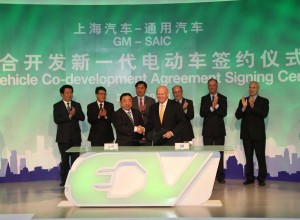
GM Chairman and CEO Dan Akerson with his SAIC counterpart Hu Maoyuan during today's signing ceremony in Shanghai.
Under pressure from the Beijing government,t General Motors has agreed to provide access to its proprietary electric vehicle technology to its lead Chinese partner.
The move is raising numerous concerns, critics contending that China is, for one thing, using unfair pressure to gain access to technologies that will later be used by its own domestic manufacturers to compete with foreign brands like GM.
But the U.S. automotive giant contends the move will help it maintain a lead in the rapid electrification of the industry – especially since China, now the world’s largest automotive market, is making a rapid push into battery power to curb its dependence on foreign oil and reduce its endemic pollution problems.
“We can accomplish far more by working together than we can by working separately,” said Tim Lee, president of GM International Operations, during a signing ceremony with the maker’s lead Chinese partner, the government-owned Shanghai Automotive Industrial Corp., or SAIC.

GM plans to begin selling the Chevy Volt - shown here in 2010 at the Shanghai Expo - in China this year.
The move followed a first-time meeting of the General Motors Board of Directors in China. The huge and fast-growing market last year generated more vehicle sales, on a unit basis, than the U.S., and GM is expecting to more than double volume to 5 million by 2015. In April, the automaker announced plans to invest between $5 billion and $7 billion to achieve that target.
The huge expansion of the Chinese auto market has created problems, leading to a significant increase in oil imports and worsening the Asian nation’s already serious urban pollution problem. That has led Beijing to press for a rapid shift to battery-powered vehicles. GM is planning to launch the new Chevrolet Volt in China later this year and will also market a European version of the plug-in hybrid, the Opel Ampera.
GM officials contend the new alliance with SAIC will help them “ to lead the auto industry in new energy vehicle technology,” said Lee, who described the shift to battery propulsion as a “very aggressive and challenging project.”
But critics note that GM has also faced significant pressure from China to accept the partnership, government regulators threatening to withhold sales incentives for the Volt were GM to have rejected the technology sharing agreement.
Such a move might violate international trade agreements, critics argued. But the more serious concern is that GM may now lose control of key intellectual property. Protection of IP rights has become a critical concern with Chinese businesses routinely ignoring trademarks and copyrights on everything from pop music and movies to pharmaceuticals and automotive design.
GM and SAIC are already involved in 10 separate partnerships, including the operation of the U.S. maker’s first Chinese plant, in Shanghai. They recently launched the new Baojuan brand to help expand sales in China’s second-tier cities.
GM sales in China rose 30% last year and have increased another 5.4% through August, even though overall demand in the market has been slipping in recent months.
To underscore the importance of the Chinese market, GM CEO Dan Akerson met with 700 employees at the PATEC technical center the maker operates with SAIC in Shanghai. That facility will be taking a significant role in the development of battery vehicles specifically for China. But critics warn that SAIC could also use its new knowledge to develop vehicles it plans to sell in direct competition to GM.
Under the strange bedfellow rules of the Chinese auto industry, SAIC not only partners with GM but also its German arch-rival Volkswagen AG. Longer-term, critics warn that SAIC intends to become a serious automotive contender on its own.
